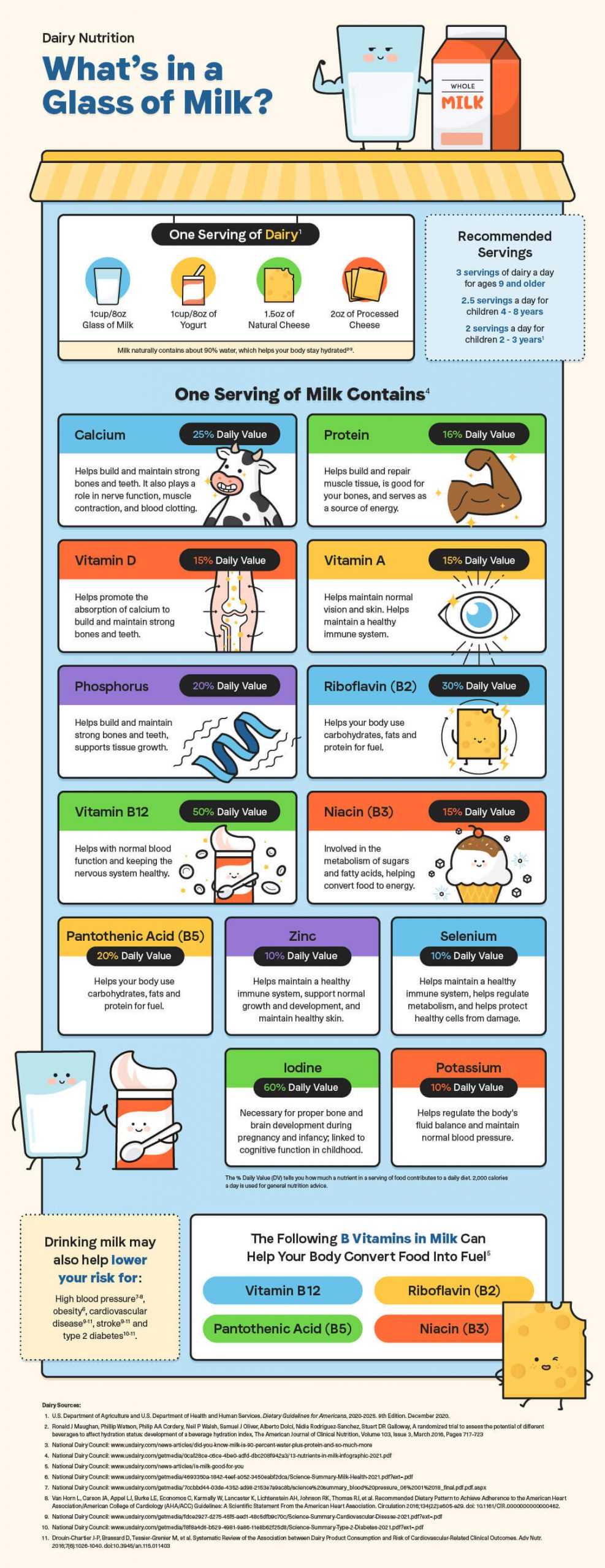Milk is one of the most nutrient-dense beverages you can consume. It’s packed with 13 essential nutrients and is even considered a superfood. Milk is a simple mix of water, healthy fats, and proteins. There are various milk options that we can reach for when we are at the grocery store. Understanding the differences between them and which one is best for our bodies can be challenging. There are probably more options than you realize! To demystify some of these delicious and nutritious options, we’re breaking each down to better help you understand which to pick next time you have to check milk off of your grocery list.
Butterfat Content in Milk
These are the kinds of milk we all know and love. Whole milk, reduced-fat milk, low-fat milk, and fat-free milk. Whether you’re team whole milk or team fat-free milk, the great news is, they all supply us with essential nutrients to keep us fueled. The difference is the amount of butterfat each contains. When milk is shipped off to the processing plant, all butterfat is removed using a cream separator. Once the milk is separated from its butterfat, we can determine what fat percentage must be reintroduced to the milk to meet consumers’ standards.
Labels – What we should know about each one
Ultrafiltered Milk
Ultrafiltered milk refers to how the milk is processed. When it’s ultrafiltered, it’s filtered to separate the water and sugar, known as lactose, from the other nutrients. What’s left is milk densely packed with protein and calcium, but low in lactose, making it a wonderful alternative for those who are lactose intolerant. Next time you’re looking for an alternative to a lactose-free option, for milk lower in sugar, or for more protein post-workout, give ultrafiltered milk a taste.
Lactose-Free Milk
For some, digesting dairy can be more difficult than for others. Part of the difficulty found in digesting dairy can be narrowed down to lactose. Lactose is a sugar naturally found in cow’s milk. By eliminating lactose sugars from milk and adding lactase, an enzyme that breaks down lactose, you’re left with milk that’s easier for those who are lactose intolerant to digest. Consuming lactose-free milk is a great alternative as it still contains the 13 essential nutrients found in milk.
Organic Milk
It’s time we debunk the term “organic milk”. Organic milk in the dairy industry refers to the farming methods and regulations necessary to qualify milk as “organic”. These farming standards eliminate any form of chemicals used in the feed that cows graze on, exclude artificial flavoring in feed, necessitate the use of organic feed, and prohibit antibiotics. Once the milk is taken to the processing plant, it’s pasteurized at a higher temperature than standard milk, a process known as ultra pasteurization. Pasteurization rids milk of any potential bacterial growth and is especially important for organic milk as these cows don’t consume antibiotics ever. During pasteurization, these higher temperatures allow for a longer shelf life than standard milk.
So, is organic milk better for you than regular milk? The short answer is no. Organic and non-organic milk is the same and offers the same nutritional value. The difference is in the farming practices, not the end product.
Traditional Buttermilk & Modern Day Buttermilk
Contrary to its name, traditional buttermilk is the residue liquid from milk after it’s been turned into butter and lacks any butterfat whatsoever. Historically, this type of buttermilk was used for pickling vegetables and has high nutritional value as it’s a cultured dairy product and contains probiotics.
Today, the buttermilk that we can find in the milk section of the store contains different ingredients than traditional buttermilk. Modern buttermilk consists of milk, lactose sugars, and casein (a protein specific to dairy products). Acidity levels rise in the liquid by adding lactic acid and lactic-producing bacteria, causing the casein to solidify. Once this process is completed, you’re left with a tangy, rich, and delicious milk beverage that’s most commonly used in baking recipes.
Flavored Milk
Though flavored milk contains additional use of sugar and flavoring, it still contains all the same nutrients and is a great source of energy. Growing children need the specific nutrients found in milk and flavored milk is often a more enticing way for them to consume those nutrients. Opting for flavored milk instead of your average energy drink is an excellent way to fuel up before any physical activity. Here’s why:
- Milk contains 13 essential nutrients that typical sports drinks don’t provide.
- Milk, even flavored milk, still contains less sugar on average than typical sports drinks.
- Milk contains proteins that help build our muscles.
- Milk is a great source of calcium and supports the growth and development of bones in children.
We all have different dietary needs and certain restrictions when it comes to food. Luckily, dairy is a cost-effective, nutrient-dense, and delicious way to get the vitamins you need. Finding a product that best suits your needs is important. Experiment with these dairy products listed above to find the kind of milk that fuels your body best.
What’s in a Glass of Milk?




